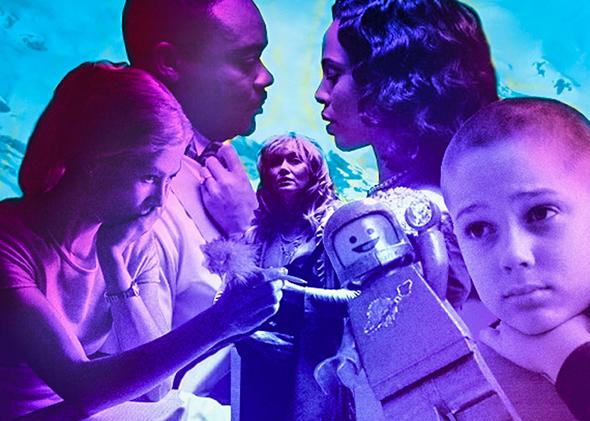How does a film critic narrow down her end-of-year list? Slate Plus asked Dana Stevens, Slate’s movie critic and the author of “The Top 10 Movies of 2014,” about the challenges of list making, movie watching, and more in this behind-the-scenes interview.
Jennifer Lai: You’ve written a Top 10 movies list every year for the past nine years. What do you take into account when you’re deciding which films should make your list?
Dana Stevens: I know it’s déclassé for critics to bitch about end-of-year list making, but I really do find the process mildly traumatic, though less during the writing than the culling phase. You’re forced to revisit a whole year’s worth of movies—of which I see probably around 150 a year, far fewer than some of my more assiduous colleagues—and you must start to quantify and measure all those disparate experiences. And a part of me just resists doing that (which is maybe why I draw the line at ranking the movies on my list, my small symbolic victory against quantification).
Once I’ve narrowed down my picks, there’s definitely a pleasure in getting to revisit the movies I loved most during the year (though sadly that “revisiting” usually involves reading and thinking about them rather than rewatching—there just isn’t time). I’ve pretty much given up on trying to achieve anything like objective criteria in making these lists—I just choose the movies I responded to the most deeply, the ones I walked out of somehow better than I went in.
I have, though, been known to take into account what you might call “genre diversity”—for example, I think comedies don’t always get their due in best-of lists, so I’ll try to include something from that category if there’s one I loved.
Of the movies on your list this year, which was a clear no-brainer pick, and why?
The movies on this list that I walked out of saying to myself “that’s a 10-best for sure” were probably Boyhood, Ida, The Lego Movie, Mr. Turner, and We Are the Best!. All the others were movies that impressed and dazzled me to varying degrees, but that only made their way onto the list during the list making process itself.
Conversely, did any movies surprise you by making it to your Top 10?
The out-of-left-field choices on there are The Missing Picture and Gone Girl—the first, because I discovered it so late in the year on a pile of unwatched DVDs, and the second because I’m well aware of its many shortcomings but somehow couldn’t resist including it anyway.
Which of these Top 10 movies is your personal favorite?
Probably Ida. I’m a sucker for movies about nuns (Black Narcissus, The Angels of Sin, The Sound of Music, you name it), and something about this film’s simplicity and purity of style just spoke to me very deeply.
Which is the one you’d most recommend to a co-worker you don’t know well?
It would completely depend on their movie tastes! Boyhood is a crowd-pleaser with something in it to appeal to almost anyone who’s been or had a kid. And Selma feels like a film that every American should see in this season of renewed racial unrest and protest. I would also ask this hypothetical co-worker if they liked horror movies, which I know are not a universal taste, and if they said yes, would send them straight to The Babadook.
Or your mother-in-law?
Hard question! My mother-in-law (who’s a big moviegoer) actually recommended a movie to me this year that I ended up reviewing fairly positively, Chef. But she is not a fan of violence, horror or extremely depressing documentaries, so that takes out Gone Girl, The Babadook, and The Missing Picture. On this list, I think she would enjoy Boyhood and Selma the most—and because she’s an art lover, maybe Mr. Turner as well, if she could stick with it through the slower stretches.
Or to a teenager?
That one’s easy—We Are the Best!, a Swedish comedy about three 13-year-old girls who form a punk band. A hilarious and inspiring movie about the struggles of growing up and fitting in, and a great portrait of teenage female friendship.
Was it hard to pick your favorites for this year, compared with years past?
I have to say this wasn’t a year in which movies were elbowing past each other onto the list (as compared with 2013, which I called in my list intro “a year of outrageous cinematic bounty.”) A couple of choices, including Gone Girl and Force Majeure, have flaws significant enough that they might have been bounced from a stronger field of contenders, but the fact they both stuck with me months after watching was meaningful enough to nudge them onto the list.
What separates the runners-up from the 10 you chose?
The runners-up part of the column is a good place to advocate for small movies that not enough people saw when they came out—Blue Ruin is one of those, as are Night Moves, Child’s Pose, and Locke. Then there are a few more widely known films that I thoroughly enjoyed while watching them: Obvious Child, Snowpiercer, The Grand Budapest Hotel—but that, at the end of the year, felt more memorable for certain elements within them—the performances of Jenny Slate in Obvious Child or Ralph Fiennes in Grand Budapest, say, or the wildly imaginative production design of Snowpiercer—than as an artistic whole.
